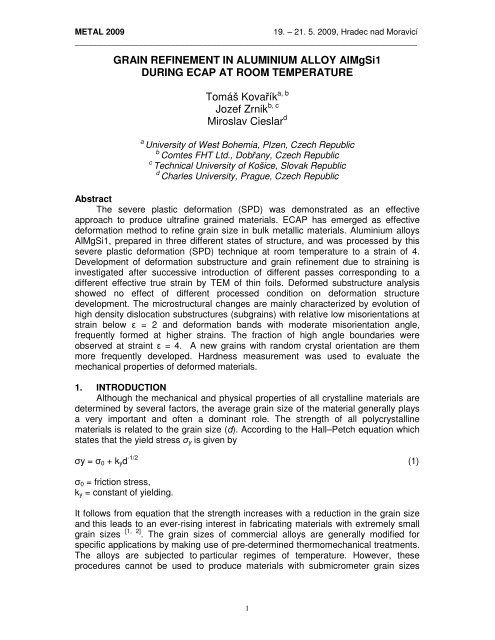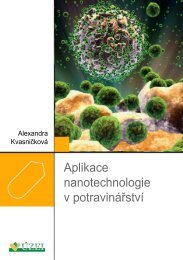GRAIN REFINEMENT IN ALUMINIUM ALLOY AlMgSi1 ... - metal 2014
GRAIN REFINEMENT IN ALUMINIUM ALLOY AlMgSi1 ... - metal 2014
GRAIN REFINEMENT IN ALUMINIUM ALLOY AlMgSi1 ... - metal 2014
You also want an ePaper? Increase the reach of your titles
YUMPU automatically turns print PDFs into web optimized ePapers that Google loves.
METAL 200919. – 21. 5. 2009, Hradec nad Moravicí___________________________________________________________________________This was followed by a process of subgrain formation in which cell walls weretransformed into more regular dislocation network (Fig. 6b). It was also found thatdifferent regions of the material displayed different rates of recovery, i.e., subgrainsin some regions were shaped concurrently with the formation of dislocation cellsin others.The ECAP die construction with a channel angle of 120° showed that it is feasible topress hard and solid <strong>metal</strong>s and alloys [6] . Our experiments complying with it but TEMprovided the evidence that applied effective strain (with Φ = 120°, 6 passes,ε EF ≈ 4) was not sufficient to deform structure uniformly. The effect of the elevateddeformation temperature had main influence (in all states) to initiation and extentof polygonization segments and nucleation of new subgrains too.3.2 Mechanical propertiesThe results of tensile testing performed at room temperature are shownin Fig. 7, which represents the three states after 6 passes. The engineering stress–strain curves are shown for comparison. Significant strengthening is evident after sixpasses in quenched and aged sample.YS of the state 3 (subsequent aged) ECAPed alloy is high as 370 MPa. This strengthis higher round off by 430% than valuation of the unECAPed material (70 MPa).The deformation curves corresponding to mechanical properties listed in table 3 forall states even in the pre-deformed stage.The strength of the quenched and subsequent aged UFG 6082 alloy is significantlyhigher than in the other stages, indicating that it is possible to add the strengtheningeffect from ECAP processing to effect from the precipitation hardening.Fig. 7. Engineering stress-strain curves:1) Initial state; 2) Annealed followed by water quenched; 3) Quenched and aged.5
METAL 200919. – 21. 5. 2009, Hradec nad Moravicí___________________________________________________________________________Table 3. Mechanical properties of commercial 6082 aluminium alloy after ECAP;<strong>IN</strong> (initial conditions); AQ (annealed followed by quenched);QAG (quenched subsequent aged); UD (un-deformed).spec.<strong>AlMgSi1</strong>D 0[mm]S 0[mm]l 0[mm]E[GPa]Rp 0.2[MPa]Rm[MPa]A g[%]A 4[%]Z[%]UD state 5,00 20,00 25,00 - 70 130 - - -<strong>IN</strong> state 5,03 19,87 25,00 58,64 302,01 321,90 5,98 11,80 38,33AQ state 4,95 19,24 25,00 73,33 178,93 208,06 5,06 14,96 46,81QAG state 5,04 19,95 25,00 64,56 369,92 394,04 2,72 10,28 44,644. DISCUSSIONS and CONCLUSIONSThe development of the dislocation density, the grain and subgrain in Al 6082alloy processed by ECAP were investigated. The grain orientation distributionreached the random case of dislocation density and the subgrain size. 6 passes inelevated temperature 150° didn´t adeguate to compose high uniform UFG structurewith the majority of high angle boundaries (60-70%).However a combination of SPD processing and precipitation hardening has thepotential to render Al 6000 series alloys. The significantly high strength of the UFG6082 Al alloy may be attributed to solid solution, grain refinement, dislocation andprecipitation strengthening (the effect of hardening particles of β-Mg 2 Si phaseprecipitated during ageing process).AcknowledgementThis paper contains results of investigation conducted as part of theMSM2631691901 project funded by the Ministry of Education of the Czech Republic.LITERATURE[1] HALL, E. O. Proc Roy Soc B, 1951, Vol. 64.[2] PETCH, N. J. J Iron Steel Inst, 1953, Vol. 174.[3] VALIEV, R. Z. Nature Mater, 2004, Vol. 3.[4] DALLA TORRE, F., et al., Pereloma, Acta Mater., 2004, VOL. 52, p. 4819.[5] CHOWDHURY, S., G., et al., Mater. Sci. Eng., 2008, A 490, p. 335.[6] ALEXANDROV, I., V., el al., Tungsten hard <strong>metal</strong>s and refractory alloys, 2000,Vol. 5, Metal Powder Industries Federation, p. 27.6





